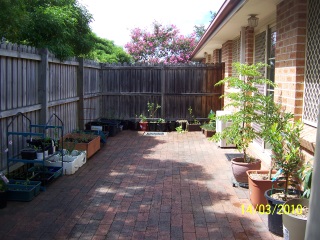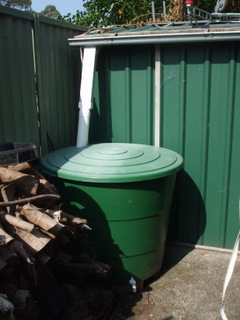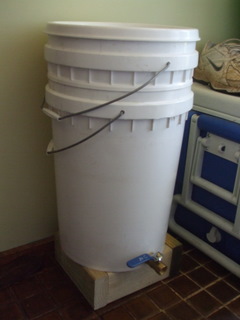Sustainable Living in a Flat, Unit or Townhouse
Created: 2011-10-30 00:27:10
While they may have some downsides when you are interested in sustainable living, ie not a lot of land around them, the higher density city type of accommodation do have a number of things going for them –
- Generally closer to transport, services and cultural areas – no need for a car, you can walk or bike to wherever you want to go.
- Smaller accommodation area meaning you don’t need as much stuff to fill it,
- Smaller enclosed area also means less energy to heat and cool
- Thicker walls and surrounding structures to provide good insulation and thermal mass
- If it’s where you are now it is a more sustainable option than building a new dwelling.
- Higher building density and possibly higher elevation may mean that frost is not an issue.
So if medium to high density is where you are (even if only for a while) and you are concerned that you want to live more sustainably, this article is written for you!
Food
You may have a, balcony, small terrace or even a courtyard in which to grow food and to make the best of what you have self watering containers are a good start. They can be placed in the best spots to catch the light or reduce the heat of the midday sun in summer and most veggies will do well in them. They are also very water efficient, they are cheap and easy to make and you can take them with you if you decide to leave, veggies and all. 
For quick, easy and cheap you might want to try a few veggie boxes based on polystyrene foam veggie containers or even some broccoli box wicking beds although if you want to move them you will need to get the water out of them first......because they are bloody heavy when full.
If you are after a more permanent structure but don’t want dig down, maybe you only have a concrete or brick surface to work on, then you should seriously consider an above ground wicking bed. They require no disturbance of your yard surface, can be built quickly, easily and reasonably cheaply from scratch and are also very water efficient. If you use wood chips as your organic layer be aware that they may cause tannin which can stain concrete or bricks when leached out of the chips and onto the ground in overflow water. A no-dig garden will also work if you don’t want to disturb the ground surface but water leaching out from under the side materials may also cause some ground staining unless you have a means of draining or retaining any excess water.
Herbs grow easily and well in containers and a few herbs go a long way, some basil, rosemary and parsley in pots will give your home grown meals a bit of flair and if you have some more space and want to go Asian some coriander and lemongrass will work well too. If you have a sunny wall you can quickly and cheaply construct some fence gardens from hessian bags and chook wire and hang them in the sun.
There are small greenhouses available these days so if you want to you can raise your own seedlings from scratch with a minimum of effort, and save yourself heaps of cash in the process and the clear plastic and tube greenhouses don’t take up much space. With some worm castings or compost (see waste, below) you can even have a go at making your own potting/seed raising mix and be more in control of your food supply.
If you are in the worst position and only have a small outside space that faces south (ie, no direct sun) it can cramp your style when trying to grow veggies but you still have options. You can try growing leaf crops that don’t require so much light or you could arrange a mirror to catch the sunlight and direct it onto your crops (a space blanket stretched across a light wood frame works well). If neither of these options work for you another way is to buy or make up some grow lights using different colour LEDs which have low power usage and can mimic the wavelengths in sunlight.
If you have little or no outside room you can still grow sprouts and microgreens. Microgreens will need some sunlight and if you can make a place for some in your small greenhouse so much the better. Sprouting using the glass jar method is easy and cheap to set up, but if you want home produced sprouts to be a major part of your diet consider making a seven day sprouter, which will easily keep a family of four in sprouts almost continuously.
Another option is a vertical aquaponics system (we are experimenting with aquaponics at the moment) where you have a container with fish in it and the water is circulated through a vertical veggie bed. These are available from our mate Charlie at Ecolicious.
Chooks can be kept in small areas but will need an area to forage if you can provide it. A deep litter set up would be best in the built up environment, provide half a square metre of floor area and 30cm of perch per chook and then cover the floor with 10 to 15cm of dry organic material such as hay, straw or wood shavings/sawdust. Throw some scratch mix (a mix of seed that chooks love) onto the deep litter every day and the chooks will keep it turned over, effectively composting their own manure in situ and keeping the smell to a minimum. Clean the pen out every 12 months or so to give yourself a load of high nutrient fertiliser that you can put on the veggies. If you don’t have enough room for full size chooks your could consider something smaller like bantam chooks or quail, they take up less space and eat less, but also produce proportionally smaller eggs.
Fruit is a little more difficult but you can keep many kinds of dwarf fruit trees (citrus, apples, stone fruit) in large pots, a house just isn’t a home without at least one lemon tree. It might be worth trying to grow them in self watering containers based on 20 litre buckets but unless you have access to a sunny area any fruiting plant will prove difficult to grow.
Water
Water capture and storage
This one can be a bit difficult but there are a number of ways to divert rainwater for storage and use if you can get access to a downpipe. One ways is just to cut into a (hopefully plastic) downpipe and then put a conventional 60 litre garbage bin, wheelie bin or plastic open head 200litre drum underneath the cut end to store your water in. There are commercially available, purpose built contraptions like a wheelie bin with a pump in the bottom of it to help you make use of harvested rainwater but the most cost effective way would be to set up a food grade open head 200litre plastic drum with a tap in the bottom and a hose connected to it. 
Greywater
The easiest way to use greywater is to slap a hose on the end of your washing machine output and then divert it to trees or lawn or perhaps even veggies if the outlet is under your mulch layer. Use the most natural biodegradable detergent or soap that you can and be aware that even soap contains sodium which can build up in your soil over time, so not too much in one place. It is not safe to store greywater, the bacterial load gets pretty high, pretty quick so if you are producing more than you can use the best thing would be to send it down the sewer for treatment, or use it to flush the toilet.
Needless to say you should always catch the first part of your cold shower water before it starts to run hot in a bucket and then put it on the veggies, but you might also consider showering in one of the larger plastic tubs (you know, the flexible ones with handles?) and then dump the shower water outside. If your bathroom is in the right area and your shower over the bath you could put the plug in and once everyone has had their shower use you faithful garden hose again to siphon it outside onto the garden. It took a lot of energy to purify that water and get it to you so make it do double duty if you can!
Reducing water use
Of course the best way to use water sustainably is to not use it at all and the first step to cutting down on your water use is to understand where it is going so do a water audit and it will give you an idea of where your highest areas of water usage are and following on from that may be some ideas on how you can reduce it. Here a few suggestions –
- If your toilet is an old single flush type, stick a brick or full 2 litre water bottle in to reduce the volume of each flush. If it is a newer dual flush/low flush toilet don’t try this trick it might reduce the volume too much.
- While we are on the subject of toilets – if it’s yellow let it mellow; if it’s brown flush it down!
- Fix any leaking taps or toilet leaks immediately
- Install a water efficient shower head, you can even take it with you when you leave.
- Take shorter showers – if you really want to be hard core, rinse yourself down, turn the shower off and soap up then rinse again. Otherwise see if you can keep your showers down to 3 or 4 minutes.
- Fit aerators to all taps
- Scrape dishes clean rather than rinsing where you can. I have heard of people pushing plates into a bucket of dry sand to remove food residue.
-
If you are buying a major water using appliance like washing machine or dish washer, go for the most water efficient one you can afford.
Energy
Depending on your circumstances a grid connected array of solar panels, are a possibility as is solar hot water if you can get access to roof area facing north, although you will have to go through the body corporate if your property is under strata title. Before you look at these more difficult, expensive and technical options to provide yourself with a more sustainable energy supply, change over to a green energy supplier and with one phone call you can reduce your energy footprint dramatically.
If you are a bit of a tech head you could put together a photovoltaic array complete with batteries and 12 volt appliances or even an inverter if you could get access to some direct sunlight, but that is somewhat beyond the scope of this article. There are, however, fairly inexpensive lights designed to be used in sheds that have a photovoltaic panel wired to some LED lights and an internal battery which could be set up to provide solar lighting with a minimum of fuss, assuming you can get access to the sunlight.
As with water, the most sustainable thing you can do about your energy usage is to reduce it, regardless of how it is generated and there are also lots of things you can do to reduce your energy use -
- Like with the water-using appliances make sure that you buy the ones with the most stars and the least consumption, including bypassing a plasma TV for an LED or LCD screen.
- Turn off lights when not in use, change to compact fluoros and open the blinds and curtains to let the sunshine in during the day.
- Heating and cooling takes extra energy so put on a jumper instead of the heater and make sure the seal on your fridge is good. Don’t put hot foods directly in the fridge either, let it cool down first.
- Tool up for low energy cooking by making a stored heat or haybox cooker, making your own solar oven and getting hold of a pressure cooker. A wok is good to have too; the quick high heat cooking in a wok is good for preserving nutrients as well as saving energy.
- Wash your clothes, hands and clean your teeth with cold water. You can have lots of hot drinks during the day by boiling up the kettle or jug once in the morning and putting the hot water into a thermos for use later.
Waste
Most urban areas have a good recycling system so if your local council has one, make us of it fully but don’t forget to avoid packaging, especially food packaging because there is so much of it, whenever you can. For your food waste, veggie peelings and other putrescible waste you can put it in a composter if you have room for one or make yourself a worm farm and keep the worms happy. Another option for those without a lot of room is to make yourself a bokashi bucket and then use the output for your worms or directly dig it in to where you intend to grow veggies. See if there is a local food co-op so you can buy what you don’t grow, but still keep your packaging waste as low as possible.
There are challenges to living a more sustainable life wherever you area but the important thing is to start on your journey now, don’t wait until you make “the move” just get stuck into it and give it a go, good luck!

